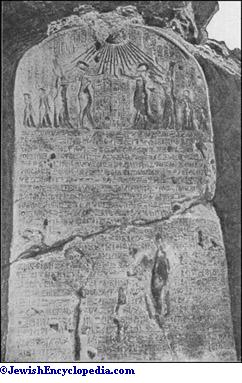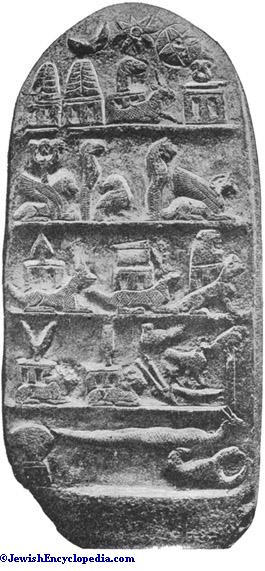BOUNDARIES:
(Redirected from FENCES.)Limits of a tract of land. When the Hebrew tribes gave up their nomadic life and settled in Palestine in agricultural communities, the most important matter was the fixing of definite boundary-lines to separate the lands of the different tribes and of the families within the tribes. The importance of this is sufficiently shown in the Book of Joshua (xv.-xxi.), where a careful record is made of the boundaries of the tribes and their families (B. B. 56a).
The Biblical law does not enter upon the details of the law concerning boundaries, contenting itself with expressing in general terms its disapproval of the crime of removing the boundary-marks. Of the important branch of the law dealing with the details of boundary-lines, party lines and walls,fences, and the like, the Bible apparently knows nothing. These form an important part of Talmudic law.
Biblical Law.The Biblical law solemnly prohibited any tampering with the landmarks: "Thou shalt not remove thy neighbor's landmark, which they of old time have set in thine inheritance, which thou shalt inherit in the land that the Lord thy God giveth thee to possess it" (Deut. xix. 14); and this law became proverbial (Prov. xxii. 28, xxiii. 10).

During the time of the Kings the primitive notions concerning the sacredness of the boundary-mark disappeared. The princes were among the first to set at naught the ancient law (Hosea v. 10; Job xxiv. 2). The rabbinical authorities, however, reestablished and enforced it. They appointed surveyors familiar with the boundaries of each estate, to take care that no landmark be removed ("Bar Maḥwanita," B. B. 68; "Meshoḥa'ah," B. M. 107b). The law was likewise inculcated by moral injunction. Sifre (Deut. 188) after quoting the text, Deut. xix. 10, says: "Has the Bible not already said, 'Thou shalt not rob' (Lev. xix. 13)? Why does it now say, 'Thou shalt not remove'? It is to teach that he who uproots the boundary-mark of his neighbor is guilty of two crimes, robbery and removal of the landmark." In a similar strain Maimonides ("Yad," Genebah, vii. 11) and the Ḥoshen Mishpaṭ (376, 1) say: "He who removes his neighbor's landmark, and thus appropriates a portion of his neighbor's property, be it even a finger's breadth, if he does it with violence is a robber, and if he does it secretly is a thief." Solomon ben Adret decided that a trespasser building on the land of his neighbor may have his house razed because the owner of the ground is not obliged to part with it or "to take money for his inheritance," but may insist upon repossession of his ground (Beër Hagolah to Ḥoshen Mishpaṭ, ib.).
The greatest care was, therefore, taken to insure accuracy of measurement in fixing the boundarylines, especially when a field was about to be sold. The form of conveyance of the field of Makpelah (Gen. xxiii. 17) shows great care in the formal terms, and refers to the "gebul," the boundary-lines of the estate. In Talmudic times, as stated above, official surveyors were appointed. In measuring two fields the surveyor was not permitted to measure the one in summer and the other in winter, because the measuring-line shrinks in summer (B. M. 61b; Shulḥan 'Aruk, Ḥoshen Mishpaṭ, 231, 18). In measuring the lines of land to be divided among brothers or tenants in common, the law enjoins great care, because in measuring lands the space of a finger's breadth is as valuable as if it were sown with crocus (B. M. 107b; Ḥoshen Mishpaṭ, l.c. 16). The lines and angles of the field had to be described, and in the deed the names of the owners of the adjoining land were given (Ḥoshen Mishpaṭ, 219, 1-5, based on B. B. 62a et seq.).
Dividing-Walls or -Fences.
 ("
("When a division of dwelling grounds held by tenants in common was made, a dividing-wall had to be built of such material as the local custom prescribed. Each of the parties had to contribute one-half of the strip on which the wall was built (B. B. i. 1). When the owners of two adjoining fields desired to build a dividing-fence, they built it on the party line, and each erected a sign on his side to indicate his ownership up to that point (ib. 2). If only one of themwished to build the fence, he had to build it entirely on his own ground (ib.). The owners of fields were not compelled by law to build boundary-fences except where local custom so prescribed, but the owners of gardens were compelled to do so (ib.; Ḥoshen Mishpaṭ, 158, 1). The prescribed height of such fences was ten handbreadths, or four ells (Ḥoshen Mishpaṭ, l.c. 3; "Yad," Shekenim, ii. 16), and the width was determined by the local custom (Ḥoshen Mishpaṭ, 157, 4). Such a fence might not have any opening in it; it must be a dead wall (ib.).

Where the boundary-fence was built to separate the lands of tenants in common, which laws had been partitioned, both parties shared the expense; and if the wall or fence fell, the materials were divided between them (ib. 3, 5).
The law of party walls in cities was quite well developed, its principles being substantially those prevailing in modern law. A party wall between two houses might be used by both owners: each might dig on his side, and put joists into the wall; but he must take care not to overload it. The weight of the material laid upon it was determined by local regulations (B. B. 6a; Ḥoshen Mishpaṭ, 153, 14, and gloss). If the wall was owned by one of the adjoining owners, the other had not the right to use it (B. B. l.c.; Ḥoshen Mishpaṭ, l.c. 15); but if he did use it, he might acquire a legal right by prescription (B. B. l.c.; Ḥoshen Mishpaṭ, l.c. 16).
If the wall was owned by one of the adjoiners, and in building it he had made holes in it on his neighbor's side, this did not give his neighbor the right to use them without the owner's consent. They might have been made as a matter of convenience simply; so that, if the neighbor was permitted to use the wall, he need not cut into it, and thus weaken it (B. B. l.c.; Ḥoshen Mishpaṭ, l.c. 19). See Easement, Neighbors.
- The subject is developed in detail in Shulḥan 'Aruk, Ḥoshen Mishpaṭ, 147, 148.


